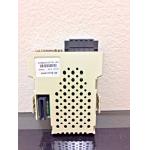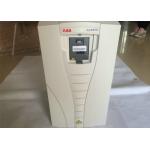NEW ORIGINAL Yaskawa Servo Amplifier 3.96KW AC servo drives SGDB-44ADS
|
|
NEW ORIGINAL 15KW SERVOPACK Input 200-230v 50/60hz 3Phase SGDB-1EADG
SPECIFICATION SGDB-44ADS
Similar Products SGDB-02ADB SGDB-02ADG SGDB-03ADB SGDB-03ADG SGDB-03ADM SGDB-05AD SGDB-05ADG SGDB-07ADM SGDB-07ADM +SGMG-06A2BBB SGDB-10AD SGDB-10ADG SGDB-10ADG SGMG-09A2A SGDB-10ADM SGDB-10ADM SGDB-15AN SGDB-10ADS SGDB-15AD SGDB-15ADG SGDB-15ADG-P SGDB-15ADGY8 SGDB-15ADM SGDB-15ADP SGDB-15ADP +SGMG-13A2AB SGDB-15ADP+SGMP-15A314 SGDB-15ADS SGDB-15ADSY18 SGDB-15AN SGDB-15AN-P SGDB-15VDY104 SGDB-1AAD SGDB-1AADG SGDB-1AADG 1 SGDB-1AADGY68 SGDB-1EADG SGDB-20AD IntroductionThis Section describes the applicability of this User
ManualThe E7 Drive is a Pulse Width Modulated Drive for AC
induction motors. This type of Drive is also known as an
AdjustableFrequency Drive, Variable Frequency Drive, AC Drive, AFD,
ASD, VFD, and Inverter. In this manual, the E7 Drive will
bereferred to as the "Drive".The E7 Drive is a variable torque AC
drive, designed specifically for HVAC applications in building
automation, includingfans, blowers and pumps. A new benchmark for
size, cost, performance, benefits, and quality, the E7 includes
numerousbuilt-in features such as network communications, H/O/A, PI, and energy-savings functions.®The E7 has
embedded communications for the popular building automation
protocols, Johnson Controls MetasysandTM®®Siemens APOGEEFLN, as
well as Modbus. There are three different types of ASD's on the market that
primarily differ in the type of rectification they use to convert
AC to DC and back to AC. C VVI - Variable Voltage Input C CSI - Current Source Input C PWM - Pulse Width Modulated These drives take the AC input voltage and frequency, covert it to DC using rectifiers, then convert it back to AC in an invertor which changes the voltage and frequency. Variable Voltage Input (VVI) The VVI is the oldest AC drive technology and was the first AC drive to gain acceptance in the industrial market. C The VVI is sometimes called a “six-step drive” due to the shape of the voltage waveform it sends to the motor. C VVI drives are fairly economical between 25 and 150 horsepower for ranges of speed reduction from 15 to 100% (about 10 to 60 Hertz). C These drives are also used widely on specialty high speed applications (400 to 3000 Hertz). Advantages: good speed range multiple motor control from one unit simple control regulator Disadvantages: Power Factor decreases with decreasing speed Poor ride through ability for low input voltage Generates significant output harmonics Low Speed Motor Cogging (shaft pulsing/jerky motion) Requires Isolation Transformer on Input Side During low speed operation (below 15-20 Hz) cogging can be a problem where the jerky motion of the motor shaft can create problems for bearings, gears, or gear reducers. where F is in newtons when B is in tesla, I in amperes, and l in
metres. This is a delightfully simple formula, and it may come as a
surprise to some readers that there are no constants of
proportionality involved in 6 Electric Motors and Drives equation 1.2. The simplicity is not a coincidence, but stems from the fact that the unit of current (the ampere) is actually deWned in terms of force. Strictly, equation 1.2 only applies when the current is perpendicular to the Weld. If this condition is not met, the force on the conductor will be less; and in the extreme case where the current was in the same direction as the Weld, the force would fall to zero. However, every sensible motor designer knows that to get the best out of the magnetic Weld it has to be perpendicular to the conductors, and so it is safe to assume in the subsequent discussion that B and I are always perpendicular. In the remainder of this book, it will be assumed that the Xux density and current are mutually perpendicular, and this is why, although B is a vector quantity (and would usually be denoted by bold type), we can drop the bold notation because the direction is implicit and we are only interested in the magnitude. The reason for the very low force detected in the experiment with the bar magnet is revealed by equation 1.2. To obtain a high force, we must have a high Xux density, and a lot of current. The Xux density at the ends of a bar magnet is low, perhaps 0.1 tesla, so a wire carrying 1 amp will experience a force of only 0.1 N/m (approximately 100 gm wt). Since the Xux density will be conWned to perhaps 1 cm across the end face of the magnet, the total force on the wire will be only 1 gm. This would be barely detectable, and is too low to be of any use in a decent motor. So how is more force obtained? The Wrst step is to obtain the highest possible Xux density. This is achieved by designing a ‘good’ magnetic circuit, and is discussed next. Secondly, as many conductors as possible must be packed in the space where the magnetic Weld exists, and each conductor must carry as much current as it can without heating up to a dangerous temperature. In this way, impressive forces can be obtained from modestly sized devices, as anyone who has tried to stop an electric drill by grasping the chuck will testify. OTHER SUPERIOR PRODUCTS
|
||||||||
| Product Tags: electric servo drive ac servo drive |

|
MR-S12-80A-Z33 MITSUBISHI Servo Drive AMP AC 2 Axis Option Card RF 322 |

|
ACH550-01-031A-4 ABB AC Hvac Drive 550 Series IEC Installation Setup 380-480 VAC |

|
3G3JX-A4004 OMRON JX Frequency Inverters AC Drive 1/2HP 480V 0.4KW 3PH |

|
EMERSON SM-ETHERNET ETHERNET MODULE RJ45 CONNECTIVITY Drive Interface |

|
ABB Inverter Standard AC Drive ACS-550-01-059A-4 380-400V 30kw 59A Low Voltage Drives |

|
A20B-0007-0040/04A PC BOARD DI/DO BOARD I/O RELAY CARD 6T/M CONTROL CNC |



